Rustic camping near Big Water, Utah offers primitive sites across multiple BLM and National Recreation Area lands in high desert terrain at elevations ranging from 3,700-4,200 feet. Summer temperatures can exceed 100°F with potential for strong winds, while winter brings below-freezing nights. Soil conditions vary from compact clay to loose sand, requiring careful site selection during different seasons.
What to do
Explore canyon rims: Near Soap Creek - Dispersed Camping, you can walk to dramatic canyon overlooks. "If you walk a mile or a mile and a half passed the first spot on the right round, you come to an amazing little canyon with the Colorado river running in it," notes Michael S. The area offers opportunities to see endangered California Condors.
Wildlife observation: At Corral Dispersed, expect encounters with grazing livestock. "If you like cows.. well you're in luck. They will come visit. You have to 'cow resistant' your space, they are curious and will poke around if you give them reason," explains David H. This area is also known for its morning cattle calls which echo against rock faces.
Stargazing: The dark skies in this region provide exceptional star viewing opportunities. Brad B. from Soap Creek Dispersed notes, "Stargazers will not be disappointed. We woke up at 3:30 am to see the Milky Way from the horizon to the opposite horizon." Limited light pollution makes this area ideal for night sky photography.
What campers like
Isolation and quiet: Primitive camping spots around Big Water offer significant distance between sites. "We set up at site at very end after right at y and no one was near us," reports Sam M. about Soap Creek. The remote locations provide genuine solitude even during busy seasons.
Morning landscapes: The desert terrain creates memorable sunrise experiences. "Sunrise was spectacular" at State Line Spot Dispersed Camping, according to Noah E. The open terrain gives unobstructed views of dawn colors across the desert landscape.
Rock formations: The geology surrounding dispersed sites offers unique exploration. Erin V. describes Ferry Swale Rd - BLM Dispersed Campsite as having "Roads good. Views killer. Remote, though not much cover for privacy." Many campers report spending hours exploring the unusual rock formations within walking distance of their sites.
What you should know
Wind exposure: Without natural windbreaks, campsites experience significant wind. Carol C. explains, "When the wind storms hit I suffered. Sand was in everything. But no wind... great spot." Wind conditions worsen in spring and fall afternoons.
Road washouts: Many access roads deteriorate quickly after rainfall. Robert F. warns about Glen Canyon NRA Wildcat Tank dispersed: "BEWARE you need 4x4 and high clearance. You absolutely will get very stuck if you attempt it in anything else."
Livestock interactions: Cattle freely roam dispersed camping areas. Meghan B. notes, "Cows roaming the area, a couple horses were in the corral." Campers should secure food items and be prepared for curious livestock visiting sites.
No shade coverage: Sites lack natural shade. Chris S. observed one location had "very dry and no shade. A few campfire rings and was perfect at night." Summer temperatures regularly reach 95-105°F during mid-day, making shade structures essential.
Tips for camping with families
Watch for hazards: The desert environment presents specific risks for children. Katrina C. cautions, "Sand spurs are prevalent- so watch your pups!" The same applies to children who should wear closed-toe shoes around camp.
Canyon safety barriers: Sites near canyon edges have no safety rails or barriers. One camper describes their spot as "overlooking Lake Powell and with beautiful rocks behind us." Families should establish strict boundaries for children near dropoffs.
Arrival timing: For optimal site selection, arrive during daylight hours. David R. advises, "Best advice is to arrive during the day" at Glen Canyon Dam Bridge Outlook, where "traffic wasn't too noisy and the view was gorgeous in the morning."
Tips from RVers
Leveling requirements: Most sites require significant leveling. Caryn H. reports, "We required leveling blocks, but it was worth it" at State Line Spot. Bring extra leveling equipment for the uneven terrain.
Turnaround space: Check site dimensions before committing. Amanda P. found State Line Spot "worked out nicely with our 20 foot trailer (with space to turn around)." Many sites have limited turnaround areas for larger rigs.
Road texture variation: Access roads transition between packed dirt and soft sand. Alex and Tanya B. note, "A bit bumpy on the dirt road to the site, but we managed our 30ft RV ok" at Ferry Swale Rd. Scout ahead when possible before committing larger vehicles to unknown road conditions.
Sand traps: Watch for deep sand pockets that can trap vehicles. Katrina C. warns, "Watch out for the big sand pit towards the back. Apparently others have gotten stuck in it." The sand consistency changes dramatically with recent weather conditions.













